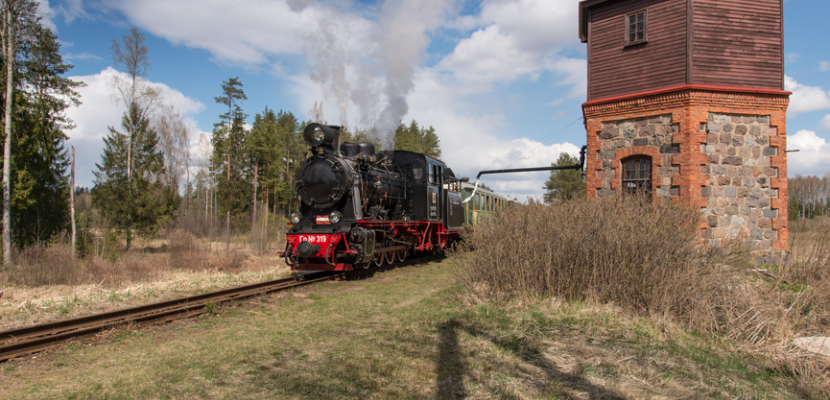Image

Reviving Industrial Heritage around Gulbene-Alūksne narrow-gauge train - Bānītis
Published on 07 November 2018

Latvia
This is the good practice's implementation level. It can be national, regional or local.
About this good practice
Bānītis narrow-gauge train runs all-year-round between two cities of Northern Latvia region - Gulbene and Alūksne - covering 33km twice daily; in summers on Saturdays, a steam-engine locomotive attract numerous local and international visitors, and every autumn an international festival is organized.
However, in order to make the train ride even more attractive for visitors, during the past 2 years substantial activities have been carried out to revive the industrial heritage around the Bānītis route: Both stations at Gulbene and Alūksne now have interactive railway-themed expositions as of 2018, in Alūksne the former railway luggage shed has been completely renewed (with ongoing plans to reconstruct the nearby station building and locomotive turning platform), while in Gulbene the huge railway station now hosts railway history exposition mostly for the younger visitors. In between the two cities, at Stāmeriena village, a train-carriage look-alike has been installed above the ground in the trees as a view platform, while Paparde station's water tower has been reconstructed for the steam locomotive already before.
In addition, in Gulbene a draisine and rail-bikes are available for the more active visitors; both station also have connections to the greenways lines, making the railway experience part of a larger network for those wishing to cycling or hike.
Bānītis is the only narrow-gauge passenger train in the Baltic State that runs twice everyday, all year round.
However, in order to make the train ride even more attractive for visitors, during the past 2 years substantial activities have been carried out to revive the industrial heritage around the Bānītis route: Both stations at Gulbene and Alūksne now have interactive railway-themed expositions as of 2018, in Alūksne the former railway luggage shed has been completely renewed (with ongoing plans to reconstruct the nearby station building and locomotive turning platform), while in Gulbene the huge railway station now hosts railway history exposition mostly for the younger visitors. In between the two cities, at Stāmeriena village, a train-carriage look-alike has been installed above the ground in the trees as a view platform, while Paparde station's water tower has been reconstructed for the steam locomotive already before.
In addition, in Gulbene a draisine and rail-bikes are available for the more active visitors; both station also have connections to the greenways lines, making the railway experience part of a larger network for those wishing to cycling or hike.
Bānītis is the only narrow-gauge passenger train in the Baltic State that runs twice everyday, all year round.
Expert opinion
The good practice is an excellent example of reviving precious industrial heritage in order to diversify the local tourist offer. EU regions could further study the example with regards to financing such a project from EU funds. Besides boosting the local tourist numbers the revived industrial heritage additionally sheds light on other attractions in the region.
Resources needed
The total costs of reviving industrial heritage around Bānītis during the last 2 years is estimated at around 700 000 EUR, both from the EU and National-funded projects.
Evidence of success
The ongoing improvement of industrial heritage objects around Bānītis narrow-gauge train will, undoubtedly, increase the number of visitors not only at the objects themselves, but also the number of passengers who use Bānītis train.
Due to the very recent opening of many of the objects, it still remains to be seen how many more visitors the area will attract, but the measurement systems are in place to demonstrate the success in the coming years.
Due to the very recent opening of many of the objects, it still remains to be seen how many more visitors the area will attract, but the measurement systems are in place to demonstrate the success in the coming years.
Potential for learning or transfer
The recent activities of reviving the Industrial Heritage around Bānītis narrow-gauge train, without a doubt, has a huge potential for transfer to other regions that have former (narrow-gauge) railway infrastructure, and are facing decrease in the passenger and visitor numbers.
By offering the visitors more activities at the destinations, as well as the railway stops in-between, the visitors now have the opportunity to spend more time exploring the nearby attractions, which, as a result, benefits the local economies.
Interreg Europe project CHRISTA one of the key areas is Industrial Heritage; the project is the only case involving heritage railways for potential transfer to other regions in setting up an interregional cooperation project on 'Railways Industrial Cultural Heritage: Developing European Sustainable Tourism' (RICH-DEST), in association with partners in Greece, Cyprus, Italy, UK, Romania, Spain and European Cultural Tourism Network.
By offering the visitors more activities at the destinations, as well as the railway stops in-between, the visitors now have the opportunity to spend more time exploring the nearby attractions, which, as a result, benefits the local economies.
Interreg Europe project CHRISTA one of the key areas is Industrial Heritage; the project is the only case involving heritage railways for potential transfer to other regions in setting up an interregional cooperation project on 'Railways Industrial Cultural Heritage: Developing European Sustainable Tourism' (RICH-DEST), in association with partners in Greece, Cyprus, Italy, UK, Romania, Spain and European Cultural Tourism Network.
Further information
Website
Good practice owner
You can contact the good practice owner below for more detailed information.
Organisation
Vidzeme Tourism Association / Latvian Greenways Association

Latvia
Latvija
Contact
Project Finance Manager